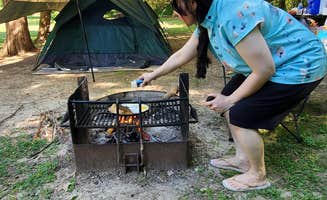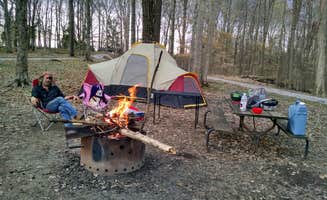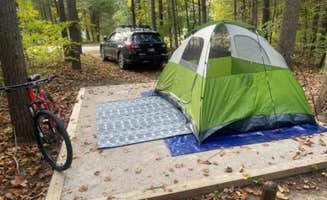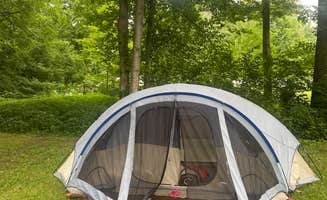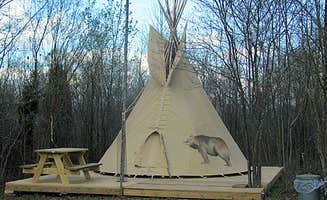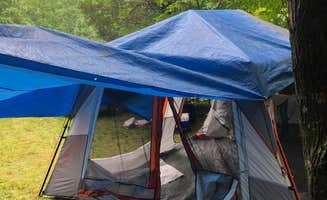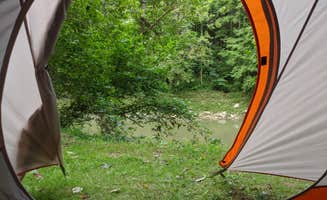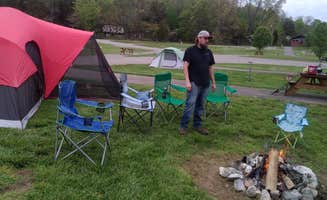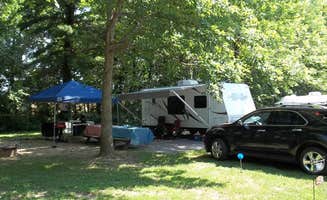Camping in Hoosier National Forest encompasses more than just the national forest itself, with camping opportunities extending into surrounding state forests and recreation areas. Elevations range from 440 to 800 feet above sea level across this region, creating varied terrain for camping. The forest's mixed hardwoods provide ample shade during summer months when temperatures typically reach the mid-80s and high humidity levels are common.
What to do
Creek exploration and swimming: Smaller waterways throughout the region offer alternatives to lake swimming. At Sycamore Springs Park, visitors can enjoy "swimming in the creek, fishing, campfires, s'mores... Tons of playgrounds too spread throughout the campground."
Boat tours through caves: Some campgrounds offer unusual water activities beyond standard lake recreation. At Spring Mill State Park Campground, "there is a cave tour also on offer in which you ride thru the cave system in a boat. Yes there are even lifevests for customer to wear!"
Hiking varied terrain: Trail networks connect many forest campgrounds with varied difficulty levels. The Youngs Creek Horse Camp area provides "a trail that loops back to the site for easy hiking access" and campers note the "chorus frogs do roar through the night. 100% worth it, make sure to bring bug spray."
What campers like
Secluded sites with water views: Campers consistently praise lakefront camping options. At Starve Hollow State Rec Area Campground, "the full hook-up sites are spacious with most offering a nice tree canopy. A large number of electric only sites are bordering the 145-acre Starve Hollow Lake with a large swimming beach."
Affordable primitive camping: Free camping options exist for those willing to forego amenities. Blackwell Campground offers "no set camp spots but great to set up and have no light pollution! Close to town but also right off some amazing trails!" One camper noted it was "quiet with sparse campers. People who were there were nice and we felt safe."
Historical features: Beyond natural attractions, history-focused amenities receive high marks. Spring Mill State Park includes "a pioneer village for touring along with a visitor center honoring astronaut Virgil Gus Grissom. Offers good fishing at the lake, electric motors only, but does offer trout."
What you should know
Site leveling challenges: Many campsites throughout the region require careful setup. Reviews note that at Starve Hollow, "our site was on a small hill so it was well distanced from all the other campers," while at other locations, some sites are "heavily sloped."
Seasonal crowding patterns: Camping areas vary significantly in usage patterns. At Patoka Lake Campground, one camper reported: "We stayed Thursday through Saturday night. Thursday we were the only campers in the entire campground! Creepy but nice. MAKE SURE TO PUT AWAY ALL OF YOUR FOOD!!! Even scraps and Yes even DOG FOOD. We had raccoon visitors both nights."
Cell service limitations: Connectivity varies significantly across the region. At Patoka Lake, "Cell service was poor. (T-Mobile 0-1 bar LTE, AT&T 1-2 bars LTE, but NO internet service when things get busy Thursday to Sunday afternoon...weird)." Other locations report similar limitations with 1-2 bars at best.
Tips for camping with families
Kid-friendly activities: Beyond standard playgrounds, some locations offer unique attractions. At Paynetown Campground, "the activity center has programs all the time and there is always something going on there... The beach, the trails, the geocaches on the trails, kayak and boat rentals, the activity center. There is something for everyone."
Halloween camping: Several campgrounds host special fall activities. At Patoka Lake, "During our visit over fall break, the Halloween festivities and trick-or-treating added an extra layer of fun to our experience." Another camper noted they "had a Trick or Treat night, and it was fun to see all of the creative costumes and kids (and adults) having fun."
Site selection strategy: Families should book early for premium locations. At Paynetown, "you have to reserve a spot early to get one with shade on busy weekends" for non-electric tent camping, while other campgrounds recommend selecting sites away from high-traffic areas.
Tips from RVers
Dump station timing: Plan accordingly for busy departure days. At Patoka Lake, there are "4 dump stations at exit but still lines due to shear number of sites but things moved quickly."
Limited water access: Not all sites offer convenient water hookups. At Patoka Lake, "It's worth noting that there are no water hookups, so remember to fill your tank before arriving at your site." At other locations, campers advise filling tanks at designated stations before proceeding to campsites.
Site leveling requirements: RV campers should bring leveling equipment. One camper at Blackwell Campground noted, "Plenty of flat land making leveling easy. Wide open so solar charging was easy," while others warn about significant sloping at sites throughout the forest region.


